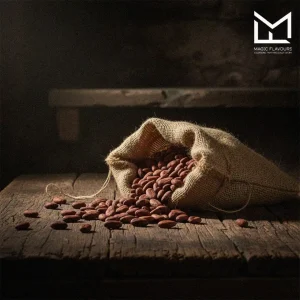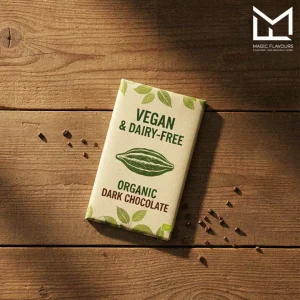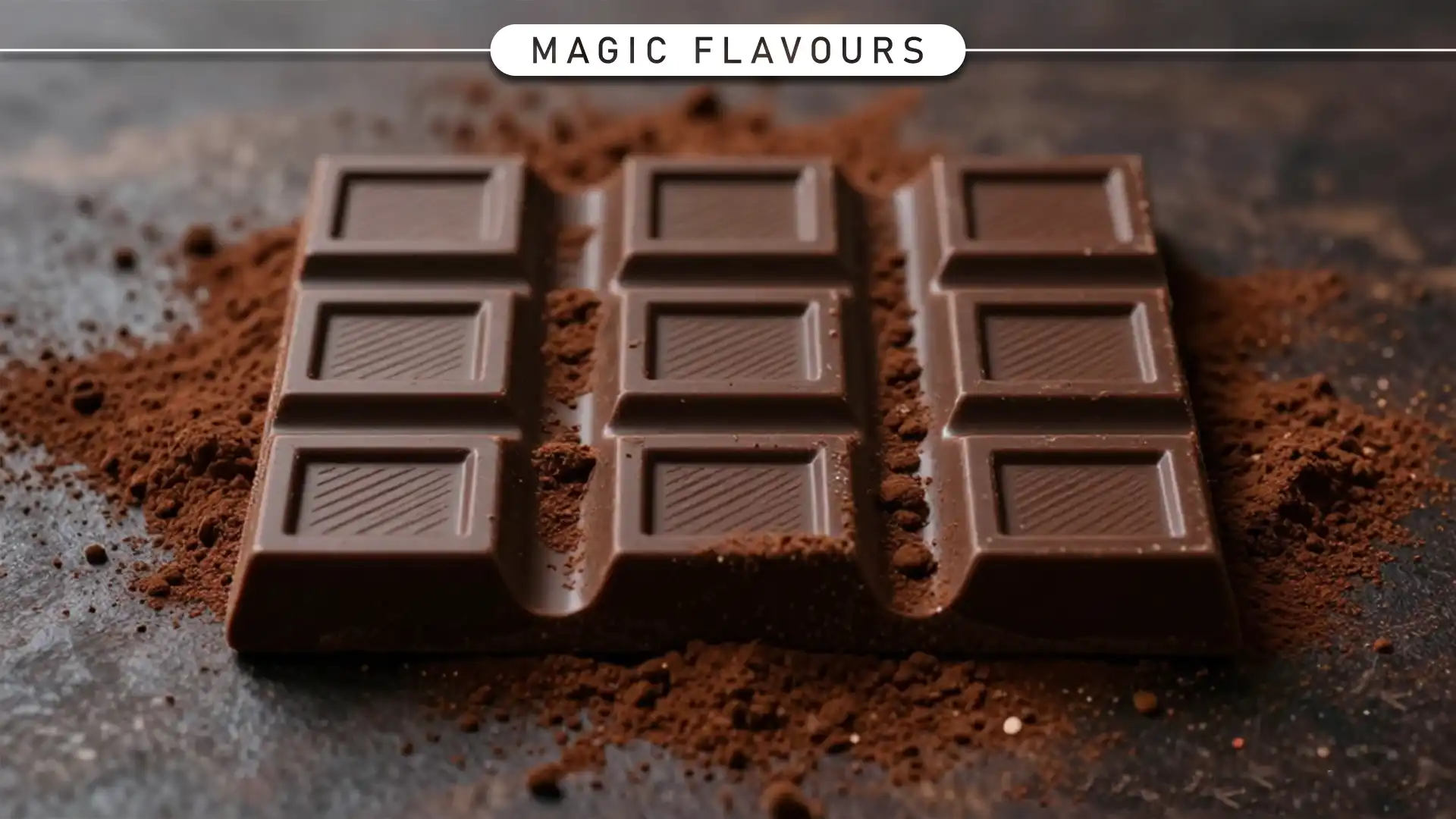1. Introduction
What Is Chocolate Flavor Powder?
A Brief Definition

Chocolate flavor powder is a dry blend used to add chocolate taste to foods and drinks. Because it’s shelf-stable and easy to use, manufacturers and home cooks rely on it daily. Typically, it contains cocoa powder, sugar, and sometimes milk solids or flavor enhancers. While some versions use real cocoa, others rely on artificial compounds to mimic chocolate’s taste. Thanks to its versatility, chocolate flavor powder appears in everything from desserts to beverages.
Why It’s Loved Worldwide
Across cultures, chocolate flavor powder brings comfort, nostalgia, and indulgence. Since it dissolves quickly, it’s perfect for instant drinks and quick recipes. Moreover, its affordability makes it accessible to households and food industries alike. Whether in a cozy cup of cocoa or a rich chocolate cake, it delivers consistent flavor every time. As global demand for chocolate grows, this powder remains a beloved staple in kitchens around the world.
2. Origins and Composition
The Anatomy of Chocolate Flavor Powder
Cocoa vs. Chocolate: What’s the Difference?

Although cocoa and chocolate are closely related, they serve different roles in flavor powders. Cocoa refers to the dry solids from roasted cacao beans. Because it’s unsweetened, cocoa delivers a pure and intense taste. Chocolate, on the other hand, includes cocoa plus sugar and fat. Therefore, chocolate flavor powder often mimics chocolate’s sweetness and creaminess. While cocoa offers depth, chocolate powder provides balance and indulgence.
Key Ingredients and Their Roles
Chocolate flavor powder blends several ingredients to achieve its signature taste. Cocoa powder adds richness and complexity. Sugar enhances sweetness and makes the flavor more approachable. Milk solids contribute creaminess and smooth texture. Emulsifiers help the powder dissolve evenly in liquids. Additionally, stabilizers preserve freshness and consistency. Each ingredient plays a vital role in creating a satisfying chocolate experience.
Natural vs. Artificial Flavoring
Natural chocolate flavor powder uses real cocoa for authentic taste. Because it’s minimally processed, it retains antioxidants and subtle bitterness. Artificial versions rely on synthetic compounds to mimic chocolate’s flavor. These powders often cost less and dissolve more easily. However, they may lack the depth found in natural cocoa. Choosing between them depends on your recipe, budget, and taste preference.
3. Production Process
How Chocolate Flavor Powder Is Made
From Cocoa Bean to Powder
Chocolate flavor powder begins with the humble cocoa bean. After harvesting, farmers ferment and dry the beans carefully. Once dried, the beans are roasted to unlock their rich aroma and flavor. Then, they’re ground into a thick paste called cocoa liquor. Manufacturers press this liquor to separate cocoa butter from solids. Finally, the solids are dried and milled into fine cocoa powder. This powder becomes the base for chocolate flavor blends.
Industrial vs. Artisanal Methods
Industrial production focuses on speed, consistency, and scale. Machines roast, grind, and blend ingredients with precision. Because of automation, large batches maintain uniform taste and texture. Artisanal methods, however, prioritize flavor depth and craftsmanship. Small producers often roast beans in unique ways to enhance complexity. Although slower, artisanal techniques offer richer, more nuanced chocolate profiles. Choosing between them depends on your priorities—efficiency or flavor.
Quality Control and Flavor Consistency

To ensure quality, producers test each batch for taste, texture, and purity. They monitor roasting temperatures and ingredient ratios closely. Because cocoa varies by origin, consistency requires careful blending and calibration. Advanced labs check for contaminants and moisture levels. Additionally, sensory panels evaluate flavor before release. These steps guarantee that every spoonful of chocolate powder meets expectations—whether in a café or a home kitchen.
4. Culinary Applications
Where Chocolate Flavor Powder Shines
In the Kitchen: Baking and Cooking
Chocolate flavor powder adds depth and richness to everyday baking. Because it blends easily, it’s perfect for cakes, cookies, and brownies. Whether you’re making a quick dessert or a gourmet treat, this powder delivers consistent flavor. Additionally, it enhances savory dishes like chili or mole with subtle complexity. Since it’s shelf-stable, home cooks love its convenience and versatility. With just a spoonful, recipes transform into chocolatey delights.
Beverage Magic: Hot Chocolate, Smoothies, and More

For drinks, chocolate flavor powder works wonders. It dissolves quickly, making it ideal for hot chocolate and milkshakes. Because it pairs well with dairy and plant-based milks, it suits every lifestyle. Smoothies gain richness and indulgence with just a dash. Moreover, baristas use it to craft mochas and flavored coffees. Whether warm or cold, chocolate powder turns simple beverages into comforting treats.
Commercial Uses: Ice Cream, Candy, and Packaged Foods
In the food industry, chocolate flavor powder is a go-to ingredient. Manufacturers use it in ice cream, candy bars, and snack coatings. Because it’s cost-effective and easy to store, it suits large-scale production. Packaged foods like breakfast cereals and protein bars rely on it for flavor. Additionally, it ensures consistency across batches and seasons. From frozen desserts to shelf-stable snacks, its applications are endless.
5. Nutritional Profile
Is Chocolate Flavor Powder Healthy?
Calories, Sugar, and Cocoa Content

Chocolate flavor powder varies in nutritional value depending on its ingredients. While some powders are rich in cocoa, others contain more sugar. Because sugar adds sweetness, it also increases calorie content. On average, one tablespoon may contain 20–50 calories. If the powder includes milk solids, fat content may rise slightly. Therefore, checking the cocoa percentage helps you choose healthier options. When cocoa is the main ingredient, the powder offers more flavor and fewer empty calories.
Antioxidants and Mood-Boosting Compounds
Cocoa naturally contains antioxidants like flavonoids, which support heart health and reduce inflammation. Because these compounds survive processing, high-cocoa powders retain some benefits. Additionally, cocoa includes theobromine and phenylethylamine—mood-enhancing chemicals. These compounds may improve alertness and emotional well-being. However, artificial powders often lack these nutrients. Choosing natural cocoa-based powders ensures you enjoy both flavor and wellness. For a healthier boost, opt for unsweetened or lightly sweetened varieties.
Comparing Brands and Labels
Not all chocolate flavor powders are created equal. Some brands prioritize taste, while others focus on nutrition. Because labels reveal ingredient quality, reading them is essential. Look for powders with high cocoa content and minimal additives. Organic and fair-trade certifications also indicate better sourcing and fewer chemicals. Additionally, check for hidden sugars or artificial flavors. By comparing labels, you can find a powder that suits both your taste and health goals.
6. Market Trends and Innovations
The Evolving World of Chocolate Flavor Powder
Vegan and Organic Options

As consumer preferences shift, vegan and organic chocolate powders are gaining popularity. Because they exclude dairy and synthetic additives, they appeal to health-conscious buyers. Organic versions use cocoa grown without pesticides, offering a cleaner and more ethical choice. Additionally, vegan powders often rely on plant-based milk solids or none at all. With growing demand, brands now highlight these options clearly on packaging. Choosing vegan and organic means enjoying chocolate with peace of mind.
Functional Additives (e.g., Protein, Vitamins)
To meet modern nutritional needs, many chocolate powders now include functional ingredients. Because protein boosts satiety, it’s often added to fitness-focused blends. Vitamins like B12 or D enhance energy and immunity, making powders more than just a treat. Additionally, fiber and adaptogens are appearing in premium formulations. These additions turn chocolate drinks into wellness boosters. Whether for recovery or daily nutrition, functional powders offer flavor with benefits.
Packaging and Sustainability
Sustainability matters more than ever in chocolate powder production. Because packaging impacts the environment, brands are switching to recyclable or compostable materials. Some companies use resealable pouches to reduce waste and preserve freshness. Additionally, sourcing cocoa from sustainable farms supports eco-friendly practices. Certifications like Rainforest Alliance or Fair-Trade signal responsible choices. By choosing sustainable packaging, consumers help reduce their footprint—one scoop at a time.
7. Ethical and Environmental Considerations
Sourcing Cocoa Responsibly
Fair Trade and Farmer Welfare
Fair trade cocoa supports farmers by ensuring they receive fair wages and stable contracts. Because cocoa farming is labor-intensive, fair compensation helps improve living conditions. Additionally, fair trade programs invest in education, healthcare, and community development. When brands choose fair trade, they promote ethical practices and long-term sustainability. Consumers who support these products help create a more just supply chain. By choosing fair trade chocolate powder, you make a difference with every purchase.
Environmental Impact of Cocoa Farming
Cocoa farming affects ecosystems, especially in tropical regions. Because demand is high, some farms clear forests to grow more cocoa. This leads to deforestation and loss of biodiversity. However, sustainable farming methods reduce environmental harm. Shade-grown cocoa preserves tree cover and supports wildlife. Additionally, organic farming avoids harmful pesticides and protects soil health. When producers adopt eco-friendly practices, they protect nature while producing quality cocoa. Supporting sustainable farms helps preserve the planet.
Certifications to Look For
Certifications guide consumers toward ethical and sustainable choices. Because labels can be confusing, knowing what to look for is key. Fair Trade, Rainforest Alliance, and UTZ are trusted certifications. These programs verify fair wages, safe working conditions, and eco-friendly farming. Additionally, organic certifications ensure cocoa is grown without synthetic chemicals. When shopping for chocolate flavor powder, check for these labels on the packaging. Choosing certified products supports responsible farming and ethical sourcing.
8. Consumer Tips
How to Choose the Right Chocolate Flavor Powder
Taste vs. Cost
When choosing chocolate flavor powder, balancing taste and cost is essential. Because premium powders use more cocoa, they offer richer flavor. However, budget-friendly options often rely on sugar and artificial flavoring. While cheaper powders work well in large batches, they may lack depth. If you’re baking for guests or special occasions, investing in quality pays off. For everyday use, affordable blends still deliver satisfying results.
Reading Ingredient Labels
Reading labels helps you understand what’s inside your chocolate powder. Because cocoa content affects flavor, look for it listed first. Avoid powders with excessive sugar or artificial additives. Additionally, check for allergens like milk or soy if needed. Organic and fair-trade certifications signal better sourcing. By comparing ingredients, you can choose a powder that matches your health goals and taste preferences.
Best Brands for Different Uses

Different brands cater to different needs. Because some focus on baking, they offer intense cocoa blends. Others specialize in drink mixes with smoother, sweeter profiles. For vegan or organic options, niche brands often lead the way. If you’re making protein shakes, look for powders with added nutrients. By matching the brand to your purpose, you get better results and more satisfaction.
9. Fun Facts and Cultural Notes
Chocolate Powder Around the World
Regional Preferences and Recipes
Chocolate flavor powder adapts beautifully to local tastes across the globe. In Europe, it’s often used in rich pastries and creamy drinks. Meanwhile, Latin American countries favor darker, spiced versions for traditional recipes. Because climate and culture shape preferences, each region adds its own twist. In Asia, lighter blends with milk or matcha are gaining popularity. From breakfast cereals to festive desserts, chocolate powder finds a place in every kitchen.
Historical Uses of Cocoa
Cocoa has a long and fascinating history that spans centuries. Originally used by ancient Mesoamerican civilizations, it was prized for its energizing properties. Because it was considered sacred, cocoa often appeared in rituals and royal ceremonies. When explorers brought it to Europe, it quickly became a luxury item. Over time, cocoa evolved from bitter drinks to sweet powders. Today, chocolate flavor powder carries that legacy into modern kitchens.
Surprising Uses in Savory Dishes
Though often associated with sweets, chocolate powder adds depth to savory dishes too. In Mexican cuisine, mole sauce blends cocoa with spices and chilies. Because cocoa enhances umami, chefs use it in stews and marinades. Even in gourmet kitchens, it appears in rubs for meats and sauces. When used sparingly, chocolate powder balances acidity and adds richness. Exploring savory recipes reveals its versatility beyond dessert.
10. Conclusion
Why Chocolate Flavor Powder Deserves a Spot in Every Pantry
Final Thoughts
Chocolate flavor powder offers convenience, versatility, and indulgence in every scoop. Because it’s easy to store and use, it suits busy lifestyles. Whether you’re baking, blending, or simply craving comfort, this powder delivers consistent results. Additionally, it adapts to dietary needs and culinary trends. From classic recipes to modern creations, chocolate powder remains a trusted companion. Keeping it in your pantry means you’re always ready to add a touch of sweetness.
Future of Chocolate Flavoring
As consumer tastes evolve, chocolate flavor powder continues to innovate. Because health and sustainability matter more, brands are improving ingredients and sourcing. Expect to see more vegan, organic, and functional blends on shelves. Additionally, flavor profiles may expand with global influences and gourmet twists. With technology and creativity driving change, chocolate powder is entering a new era. The future promises more delicious, ethical, and exciting ways to enjoy chocolate.
